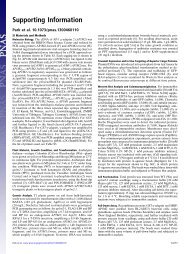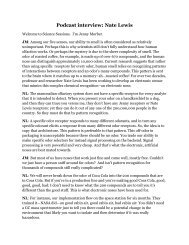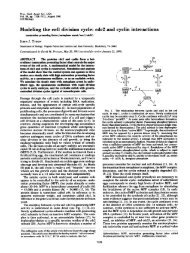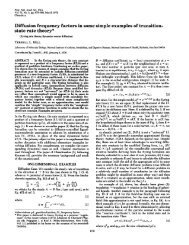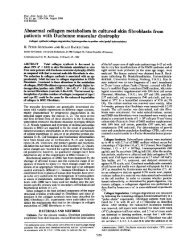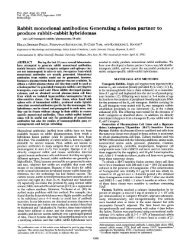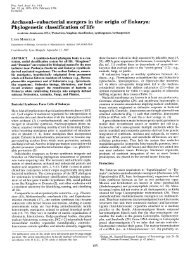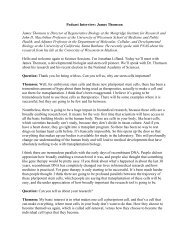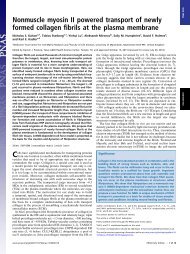Juvenile hormone and its receptor, methoprene- tolerant, control the ...
Juvenile hormone and its receptor, methoprene- tolerant, control the ...
Juvenile hormone and its receptor, methoprene- tolerant, control the ...
Create successful ePaper yourself
Turn your PDF publications into a flip-book with our unique Google optimized e-Paper software.
sequence, in which adenine <strong>and</strong> thymine were present in <strong>the</strong><br />
seventh <strong>and</strong> eighth positions, whereas guanine <strong>and</strong> adenine in<br />
<strong>the</strong>se same positions in <strong>the</strong> S24 sequence diminished binding to<br />
an undetectable level. Taken toge<strong>the</strong>r, our results suggest that<br />
<strong>the</strong> first six bases of <strong>the</strong> nine-base motif to which Met can bind<br />
are similar to <strong>the</strong> E-box or E-box–like sequences with a degenerate<br />
fifth position (ei<strong>the</strong>r cytosine or thymine). The three<br />
bases downstream of <strong>the</strong> E-box–like motif are important, <strong>and</strong><br />
two of <strong>the</strong>se bases can be degenerate with invariable guanine in<br />
<strong>the</strong> ninth position. The binding properties are similar for all<br />
tested sequence combinations with cytosine in <strong>the</strong> fifth position<br />
but not for those with thymine in that position.<br />
Discussion<br />
Our transcriptome study combined with <strong>the</strong> Met RNAi screen<br />
has revealed important biological features related to <strong>the</strong> fat<br />
body of female A. aegypti mosquitoes. Very high transcriptional<br />
activity was observed in this tissue during <strong>the</strong> JH-dependent PE<br />
development. Although we anticipated finding putative JH gene<br />
targets using microarray analysis during PE development, such<br />
a spectacular rise in transcription was unexpected <strong>and</strong> reflects<br />
<strong>the</strong> great importance of JH-regulated periods in governing<br />
gonadotrophic cycles in mosquitoes. The time-course microarray<br />
analysis has identified temporal distribution of major peaks<br />
of transcriptional activity with a large number of genes being<br />
maximally up-regulated at <strong>the</strong> beginning (1,843 genes of <strong>the</strong> EPE<br />
cluster), <strong>the</strong> middle (457 genes of <strong>the</strong> MPE cluster), or <strong>the</strong> end<br />
(1,815 genes of <strong>the</strong> LPE cluster) of PE development. Using selected<br />
EPE cluster genes, we obtained experimental proof that<br />
<strong>the</strong>se genes require a low level of JH for <strong>the</strong>ir maximal expression<br />
<strong>and</strong> are inhibited by a high level of JH; this result<br />
correlates well with <strong>the</strong> data on <strong>the</strong> JH titers in female mosquitoes<br />
PE (8). An inverse relationship exists between selected<br />
LPE genes <strong>and</strong> JH; <strong>the</strong>se genes need a high JH titer for <strong>the</strong>ir<br />
maximal expression.<br />
In our study, we have identified <strong>the</strong> significant role of <strong>the</strong> JH<br />
<strong>receptor</strong> Met in regulating transcriptional activity in <strong>the</strong> fat body<br />
of female mosquitoes PE. The RNAi transcriptome screen has<br />
shown that 1,385 genes were up-regulated <strong>and</strong> 1,169 genes downregulated<br />
as a result of Met depletion; 27% of EPE <strong>and</strong> 40% of<br />
MPE genes were up-regulated <strong>and</strong> 36% of LPE genes were<br />
down-regulated by Met RNAi. RNAi experiments using an in<br />
vitro fat-body culture demonstrated that Met mediates <strong>the</strong> action<br />
of JH. In <strong>the</strong>se experiments, selected EPE genes were activated<br />
<strong>and</strong> selected LPE genes were repressed in <strong>the</strong> Met-depleted<br />
tissue. Met RNAi depletion rendered repressive <strong>and</strong> activating<br />
actions of JH on ei<strong>the</strong>r of <strong>the</strong>se genes ineffective. It is important<br />
to stress that a large percentage of EPE, MPE, <strong>and</strong> LPE genes<br />
appear not to be <strong>control</strong>led by Met. Future research should investigate<br />
<strong>the</strong> regulation of expression of <strong>the</strong>se genes.<br />
A 9-mer consensus for <strong>the</strong> Met-binding motif CACG C / T G A / G T / A G<br />
was identified using pattern-search <strong>and</strong> EMSA analyses. The<br />
core of this motif is conserved between <strong>the</strong> mosquito A. aegypti<br />
<strong>and</strong> <strong>the</strong> moth B. mori. However, fur<strong>the</strong>r analysis is needed to<br />
establish conservation of this Met consensus sequence among<br />
o<strong>the</strong>r insects. Along with conservation, <strong>the</strong> binding sites of many<br />
transcription factors show bias for a certain position within <strong>the</strong><br />
upstream regions, because <strong>the</strong>se transcription factors can act<br />
most effectively when at a certain distance from <strong>the</strong> TSS (29, 30).<br />
The effect of positional bias for transcription factor binding sites<br />
has been observed in insects (31), vertebrates (32, 33), <strong>and</strong> plants<br />
(34). In our case, <strong>the</strong> in silico analysis determined that Metbinding<br />
motif variants showed a strong positional bias for <strong>the</strong><br />
first 300 bases of <strong>the</strong> promoters of iMet–down-regulated genes.<br />
This bias suggests that Met might be directly involved in <strong>the</strong><br />
up-regulation of some LPE genes. The fact that no such bias<br />
was detected in <strong>the</strong> iMet–up-regulated genes indicates that <strong>the</strong><br />
EPE <strong>and</strong> MPE genes might be <strong>control</strong>led indirectly by Met in<br />
accordance with some additional transcription factors. Two genes<br />
encoding <strong>the</strong> transcription factors hairy <strong>and</strong> Kr-h1 have been<br />
shown to be activated by Met, but <strong>the</strong>ir targets have not been<br />
characterized (19, 26). Overall, <strong>the</strong> complexity of JH/Met transcriptional<br />
regulation requires additional investigation.<br />
The insect fat body is a storage depot of energy reserves <strong>and</strong> is<br />
a center of metabolism, immunity, detoxification, <strong>and</strong> production<br />
of yolk protein precursors during reproduction. It responds to<br />
changing <strong>the</strong> physiological needs of an insect organism by altering<br />
<strong>its</strong> functions. Gene ontology analysis has provided insight<br />
into <strong>the</strong> biological significance of <strong>the</strong> fat body in female mosquitoes<br />
<strong>and</strong> identified large <strong>and</strong> diverse sets of differentially<br />
expressed genes during PE development. We have found that<br />
<strong>the</strong> expressions of major functional groups are temporally separated,<br />
with carbohydrate, lipid, <strong>and</strong> xenobiotics metabolism<br />
being overrepresented in <strong>the</strong> EPE <strong>and</strong> MPE gene clusters <strong>and</strong><br />
translation <strong>and</strong> transcription overrepresented in <strong>the</strong> LPE gene<br />
cluster. Met <strong>control</strong>s a large portion of <strong>the</strong>se genes; it downregulates<br />
EPE/MPE genes <strong>and</strong> up-regulates LPE genes. This<br />
unique partition of major functional gene groups reflects <strong>the</strong><br />
complexity of fat-body activities that accommodate <strong>the</strong> requirements<br />
of reproducing female mosquitoes. A newly eclosed female<br />
mosquito needs a rapid increase in carbohydrate <strong>and</strong> lipid<br />
metabolism to support nectar feeding <strong>and</strong> energy-consuming<br />
host seeking. By <strong>the</strong> end of PE development, a female mosquito<br />
prepares for <strong>the</strong> intense dem<strong>and</strong>s of post–blood-feeding reproductive<br />
events. The high expression level of <strong>the</strong> genes involved<br />
in translation, transcription, <strong>and</strong> amino acid metabolism in <strong>the</strong><br />
fat body at <strong>the</strong> end of PE development reflects a distinctive adaptation<br />
of mosquitoes as hematophagous insects. This study<br />
advances our underst<strong>and</strong>ing of JH regulation of mosquito reproduction<br />
<strong>and</strong> provides important insight into <strong>the</strong> <strong>control</strong> of<br />
gene expression by JH <strong>and</strong> <strong>its</strong> <strong>receptor</strong> Met.<br />
Materials <strong>and</strong> Methods<br />
Experimental Animals. The mosquito A. aegypti UGAL/Rockefeller strain was<br />
raised as described previously (35). Adult mosquitoes were fed continuously<br />
on water <strong>and</strong> 10% (wt/vol) sucrose solution. All dissections were performed<br />
in Aedes physiological solution at room temperature (35).<br />
Microarray Assays. Single-color hybridizations of custom-made Agilent<br />
microarrays with 15,321 A. aegypti genes were conducted at <strong>the</strong> University<br />
of Chicago Core Instrument Facility following st<strong>and</strong>ard protocols (28). Three<br />
independent biological replicates were performed for <strong>the</strong> each treatment.<br />
The raw expression data were processed using Agilent Feature Extraction<br />
Software (36). Subsequent analysis steps were performed in <strong>the</strong> statistical<br />
programming environment R using Bioconductor packages (37). The expression<br />
data were background corrected <strong>and</strong> quantile normalized with<br />
functions from <strong>the</strong> Agi4 × 44 PreProcess <strong>and</strong> Limma libraries (38). Statistical<br />
analysis of DEGs was performed with <strong>the</strong> Limma library. When filtering for<br />
DEGs, we used a fold change of ≥1.75 (0.8 in log2 scale) <strong>and</strong> an adjusted<br />
P value of ≤0.01, in accordance with our previously used filtering criterion<br />
(28). The latter was adjusted for multiple testing with <strong>the</strong> Benjamin–<br />
Hochberg method to determine false-discovery rates (39). Hierarchical<br />
clustering with complete linkage was performed with <strong>the</strong> hclust function<br />
in R. The distance matrix required for this method was obtained by computing<br />
distance-transformed Spearman correlation coefficients among <strong>the</strong><br />
expression profiles of all DEGs. Discrete clusters were obtained by cutting<br />
<strong>the</strong> resulting cluster dendrogram with <strong>the</strong> cutree function using a visually<br />
determined height value.<br />
Preparation of JH-Deprived Mosquitoes. We used a previously described approach,<br />
in which <strong>the</strong> head <strong>and</strong> <strong>the</strong> JH-producing endocrine gl<strong>and</strong>, <strong>the</strong> corpora<br />
allata, were isolated from <strong>the</strong> rest of a female mosquito body by severing <strong>the</strong><br />
metathorax <strong>and</strong> abdomen (10). The wound was sealed with paraffin, <strong>and</strong> <strong>the</strong><br />
abdomens <strong>the</strong>n were attached with paraffin to a microscopic slide. Slides<br />
with adhered abdomens were placed in Petri dishes with a wet filter paper<br />
<strong>and</strong> kept at 27 °C. These JH-deprived mosquito abdomens were prepared at<br />
6 h PE, a time of very low JH titer (8). The abdomens were treated topically<br />
with three applications of 500 pg JH III (Sigma-Aldrich) in acetone (solvent)<br />
or with acetone alone (10). JH response was characterized 24 h after hor-<br />
PNAS PLUS<br />
DEVELOPMENTAL<br />
BIOLOGY<br />
Zou et al. PNAS Early Edition | 7of9



